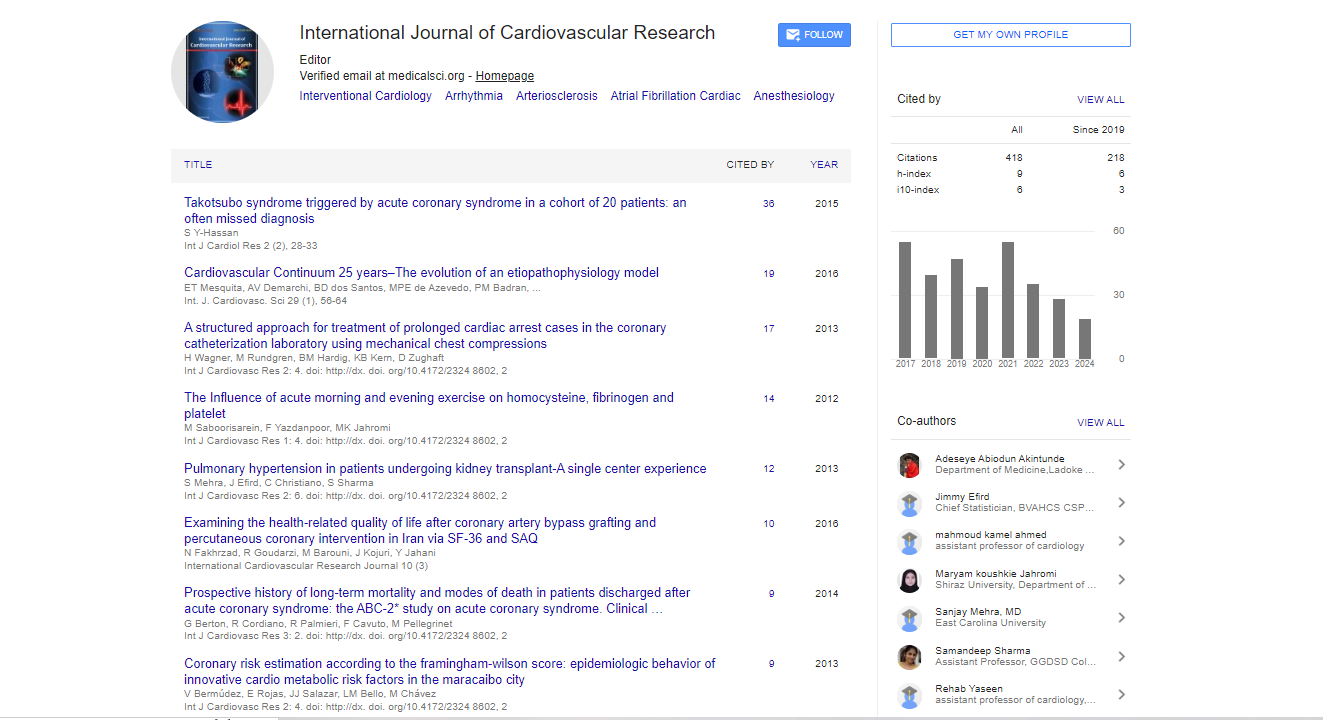Short Communication, Int J Cardiol Res Vol: 13 Issue: 3
Epicardial Function and Dysfunction: Implications for Cardiac Diseases and Therapeutic Strategies
Megan Winter*
1Department of Molecular Cell Biology, Leiden University Medical Center, Leiden, The Netherlands
*Corresponding Author: Megan Winter,
Department of Molecular Cell Biology,
Leiden University Medical Center, Leiden, The Netherlands
E-mail: winter.m@lumc.nl
Received date: 27 May, 2024, Manuscript No. ICRJ-24-144362;
Editor assigned date: 30 May, 2024, PreQC No. ICRJ-24-144362 (PQ);
Reviewed date: 13 June, 2024, QC No. ICRJ-24-144362;
Revised date: 21 June, 2024, Manuscript No. ICRJ-24-144362 (R);
Published date: 28 June, 2024, DOI: 10.4172/2324-8602.1000569
Citation: Winter M (2024) Epicardial Function and Dysfunction: Implications for Cardiac Diseases and Therapeutic Strategies. Int J Cardiol Res 13:3.
Description
The epicardium, the outermost layer of the heart wall, is essential component in cardiovascular physiology and pathology. This serous membrane not only forms the protective covering of the heart but also plays essential roles in cardiac function and disease. Understanding the epicardium's structure, function and clinical implications provides valuable analysis of its significance in heart health and disease. The epicardium is the visceral layer of the serous pericardium, a double walled sac that encloses the heart. Composed of a single layer of mesothelial cells, the epicardium lies adjacent to the myocardium and is separated from it by a small amount of connective tissue and a thin layer of adipose tissue [1]. This layer is integral to the structural integrity and functionality of the heart. Histologically, the epicardium is characterized by a simple squamous epithelium resting on a thin connective tissue layer. The connective tissue consists of a network of collagen and elastin fibers, providing both structural support and elasticity [2]. The epicardial surface is also rich in blood vessels and nerves, which are important for the regulation of cardiac function and the supply of nutrients to the heart.
The epicardium acts as a protective barrier against mechanical trauma and friction. Its smooth surface reduces friction between the heart and the surrounding pericardial sac during the cardiac cycle, facilitating the heart's rhythmic contractions and relaxations [3]. The epicardial cells secrete a small amount of serous fluid into the pericardial cavity. This fluid acts as a lubricant, minimizing friction and allowing smooth movement of the heart within the chest cavity [4]. Recent study has highlighted the epicardium's role in cardiac repair and regeneration. Epicardial cells can proliferate and differentiate into various cell types, including cardiac myocytes and endothelial cells. This regenerative potential is particularly relevant in the context of myocardial injury, where epicardial derived cells contribute to tissue repair and scar formation [5-7]. The epicardium contains specialized cells that play a role in regulating cardiac function. For example, epicardial adipose tissue secretes bioactive molecules that influence myocardial metabolism and function. Additionally, the epicardium houses autonomic nerves that modulate heart rate and contractility.
The epicardium's role extends beyond normal physiological functions into the field of pathology. Excessive accumulation of epicardial fat is associated with various forms of heart disease, including coronary artery disease and heart failure. This fat depot can produce pro-inflammatory cytokines that contribute to the development of atherosclerosis and myocardial dysfunction [8,9]. Fibrosis of the epicardium, often resulting from chronic inflammation or injury, can impact cardiac function by altering the mechanical properties of the heart and impairing its ability to contract and relax properly. This condition is frequently observed in patients with dilated cardiomyopathy and other forms of heart failure [10]. The regenerative capabilities of the epicardium have led to the exploration of epicardial-based therapies for heart disease. Strategies such as epicardial cell transplantation and the use of epicardial-derived stem cells are being investigated as potential treatments for myocardial infarction and heart failure.
Conclusion
The epicardium, while often diminished by the myocardium and endocardium, plays an important role in maintaining cardiovascular health and function. Its unique structural features, combined with its diverse physiological functions, confirms its importance in both normal cardiac physiology and the pathology of heart disease. As study continues to clarify the complexities of the epicardium, it is becoming increasingly clear that this membrane is integral to understanding and managing various cardiovascular conditions. Future study into the epicardium's regenerative potential and its role in disease will likely provide new findings and therapeutic approaches for improving heart health.
References
- Männer J, Perez-Pomares JM, Macias D, Munoz-Chapuli R. (2001) The origin, formation and developmental significance of the epicardium: a review. Cells Tissues Organs 169(2):89-103.
- Quijada P, Trembley MA, Small EM. (2020) The role of the epicardium during heart development and repair. Circ Res 126(3):377-394.
- Gittenberger-de Groot AC, Winter EM, Bartelings MM, Goumans MJ, DeRuiter MC, et al. The arterial and cardiac epicardium in development, disease and repair. Differentiation 84(1):41-53.
- Cao J, Poss KD. (2018) The epicardium as a hub for heart regeneration. Nat Rev Cardiol 15(10):631-647.
- Ho E, Shimada Y. (1978) Formation of the epicardium studied with the scanning electron microscope. Dev Biol 66(2):579-585.
- Männer J. (1993) Experimental study on the formation of the epicardium in chick embryos. Anat Embryol 187(3):281-289.
- Lie-Venema H, Van Den Akker NM, Bax NA, Winter EM, Maas S, Kekarainen T, et al. (2007) Origin, fate and function of Epicardium‐Derived Cells (EPDCs) in normal and abnormal cardiac development. The Scientific World Journal 7(1):1777-1798.
- Popescu LM, Manole CG, Gherghiceanu M, Ardelean A, Nicolescu MI, et al. (2010) Telocytes in human epicardium. J Cell Mol Med 14(8):2085-2093.
- Wessels A, Pérez‐Pomares JM. (2004) The epicardium and epicardially derived cells (EPDCs) as cardiac stem cells. Anat Rec A Discov Mol Cell Evol Biol 276(1):43-57.
- Pérez-Pomares JM, de la Pompa JL. (2011) Signaling during epicardium and coronary vessel development. Circ Res 109(12):1429-1442.
 Spanish
Spanish  Chinese
Chinese  Russian
Russian  German
German  French
French  Japanese
Japanese  Portuguese
Portuguese  Hindi
Hindi 



